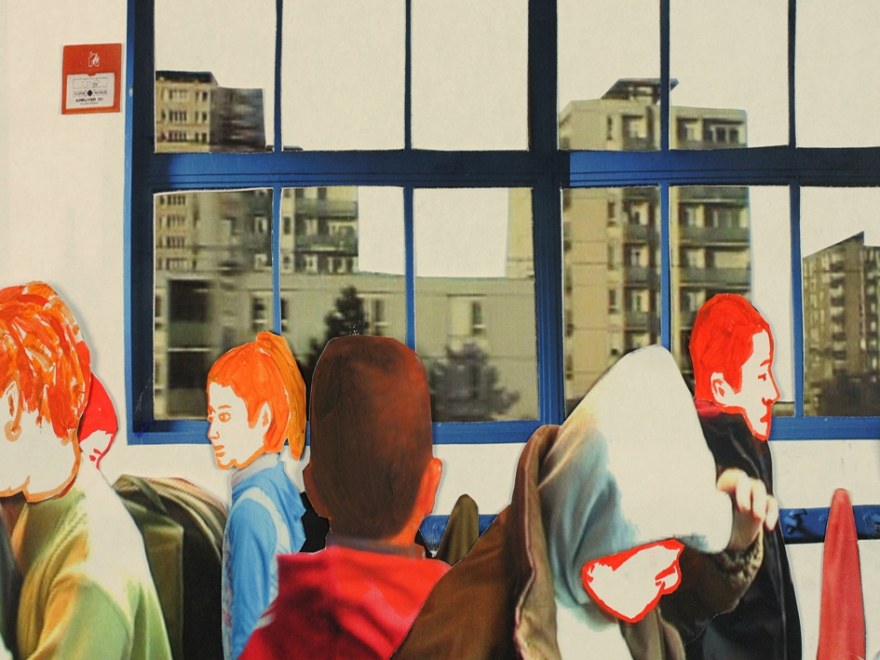Dinner with Le COD et le coquelicot
An interview with Jeanne Paturle and Cécile Rousset, directors of Le COD et le coquelicot
Le COD et le Coquelicot [The Predicate and the Poppy] mixes animated sequences with filmed characters. Were these latter actors, or did you film in a real setting?
The characters were filmed in a real setting: we filmed the classroom scenes and the winter school trip on location. When we decided to use those scenes for the animated sequences, and to keep the school teachers’ faces, we asked all five of them if we could photograph them from every angle in order to animate the characters more freely.
The voiceovers are made up of the teachers’ accounts. How did you gather them, and was that the first step in making the film?
That was in fact the first stage of the film. We spent a lot of time recording the five teachers, together, trying to recreate the light, pedagogical and funny ambiance of the school’s “hallway”, the place where they gather at recess and during their lunch break to smoke and exchange anecdotes about their classes. We had them talk a lot (nearly fifteen hours of rushes) because at the time, we didn’t know exactly what the limits of our subject would be (and we also recorded the students). Then, when we edited the accounts in order to figure out what the common theme was, it seemed clear that what interested us was the teachers’ point of view. That first sound track was the starting point for us to begin writing in earnest, then to work on the images.
Le COD et le Coquelicot questions the national education system’s pedagogical priority, between academic knowledge (the Predicate) and social knowledge (the Poppy). Do you think this question is one that concerns only our particular historical moment, or do you think it is timeless?
It’s difficult to say whether it is timeless, but in any case, it seems pretty pressing today. More or less, obviously, according to the context of any given school. In this one, there was a great divide between the very poor cultural and social environment of the local children and the requirements (sometimes the strictness) of the educational program. That seemed to us to be one of the characteristic difficulties of neighborhoods without mixed social backgrounds.
If you had to make a clear cut choice between the two audiences, would you prfer to show your film to students or to teachers?
Probably to teachers. We thought of this film as speaking more to adults than to children, and we believe that our questions connected to the profession interest mainly those who exercise it. But it would be better not to have to choose.
In their accounts, the teachers discuss at length the reasons for children’s personal inhibitions. Le COD et le Coquelicot seems to wonder about the teachers’ own inhibitions. Did you also have inhibitions when making the film?
Just like all documentary filmmakers, we had doubts about the way we were using the words and images of our five instructors. They trusted us, and we did not want to betray that or make them uncomfortable. At the same time, making a film means making editing choices, selecting images, bringing one’s own voice, and naturally not all of the teachers were going to find themselves faithfully represented. If we had inhibitions, they were linked to these questions of trust, but I don’t think we were really conscious of that.
Le COD et le Coquelicot mentions the different spheres in a school setting: the children, the families, the external environment, the children’s relationship to groups, their relationship to learning, etc., which is compared to the sphere of the teachers. Why did you choose not to have the children speak, or their families, why did you not talk about class friends and enemies, politics, child psychologists?
At the very beginning, even before we began looking for a producer and for financing, all we knew was that we wanted to talk about that particular school. We thought we were going to have everyone speak, everyone who takes part in the life of the school. And then, as our topic became clearer, it was the teachers’ voice that was the loudest, in all likelihood because it was the closest to our own personal questions. (Both of us were working at the school at that time; we were dealing with the same issues.) Since we were using animation, we knew that we could not make a very long film, so we had to makes some choices. (Animation takes a lot of time! At the beginning, even the twenty-four minutes of the eventual film seemed unmanageable.) We couldn’t talk about everything, so we chose to follow the voice of this little group of teachers. Everything else will be for other films!
You present the carefreeness of the winter holidays as something like a moment of joyful reprieve for the children. At the same time, you show a scene of a teacher suffocating in all that happiness. Do you think the teacher’s profession is built on that bittersweet feeling? Did you already know first hand what it was like to be a teacher or children’s organizer?
Yes! We both work with children. (Cécile is an art teacher in primary school, while Jeanne works as a specialist for young children and was an organizer in that school at the time.) It’s precisely because we wallowed in that bittersweet feeling that we had such a strong attachment to that place, to those children, those jobs, and at the same time a real feeling of hopelessness that accompanies the attachment. That’s why we really wanted to make the film.
Lastly, Le COD et le Coquelicot is a French production. In your opinion, what does the French film industry offer that others don’t, as far as short films are concerned?
We don’t know how to answer that question.
Maybe a type of freedom to work in a particular way…
Programme for viewing Le COD et le Coquelicot: National Competition F12.








